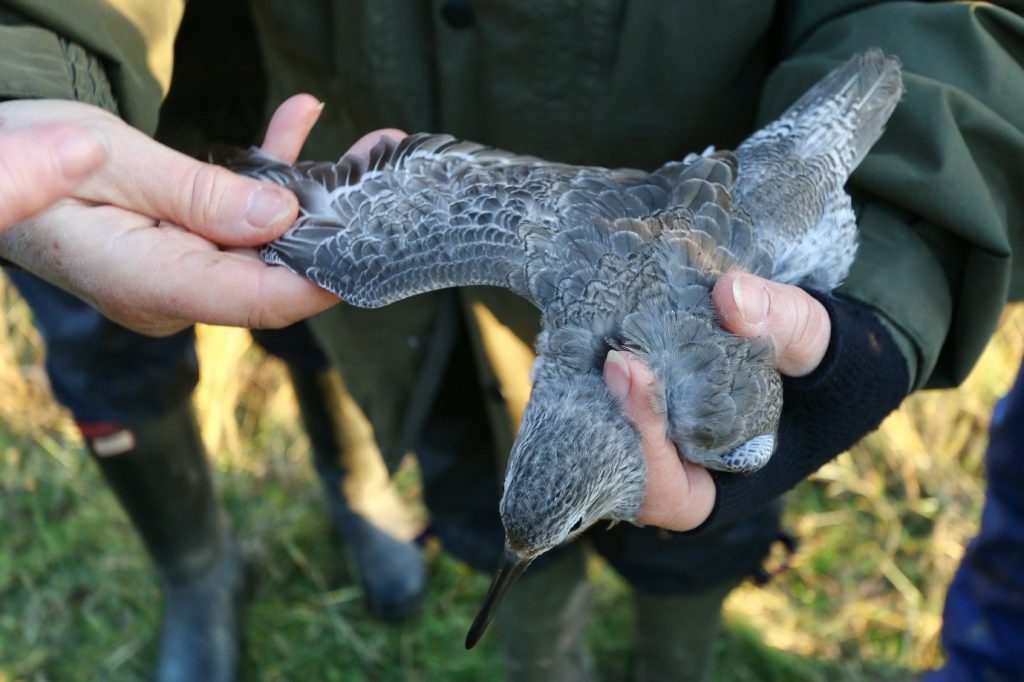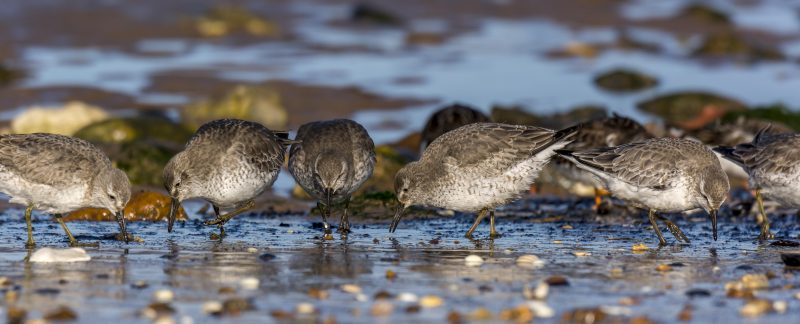The Wash Wader Ringing Group recently received a recovery report from the BTO of a WWRG-ringed Knot caught in Guinea-Bissau: the first recovery of one of our Knot in that country. This fascinating recovery prompted a more-detailed look both at the circumstances of this bird’s capture and the historical records of Wash recoveries from western and southern Africa.
SX20418 was ringed as a juvenile during a mist net catch at Terrington Marsh, Norfolk on 15 December 2001, one of fifteen Knots in the catch, all un-ringed birds with the exception of one control, ringed at Holme-next-the-Sea on 4 November 1990. SX20418 was next caught nineteen years later on Orango, one of the islands of the Arquipélago dos Bijagós, Guinea-Bissau (11o 1’N 16o 3’W) on 26 January 2020.

The Arquipélago dos Bijagós is a group of 88 islands and islets located in the Atlantic Ocean off the coast of Guinea-Bissau in West Africa, 4,872 kilometres from Terrington Marsh. SX20418 was caught in a mixed-species high-tide roost by a team from the University of Lisbon led by Teresa Catry. The team caught 31 Knots on 26 January, all un-ringed birds except for this WWRG control. Teresa’s team has caught a total of 173 Knots in Guinea-Bissau including two more recoveries, one from France (on 28 January 2020) and another from the Netherlands (on 7 April 2019).
Two races of Knot (Calidris canutus) occur in western Europe, islandica and canutus, differentiated to subspecies level based on a study in The Netherlands where both populations regularly occur in the Wadden Sea, on autumn and spring migration (Roselaar 1983). So far as is known, almost all the Knots that occur on the Wash both on migration and in winter belong to the race islandica. There have, however, been a small number of records of Knots ringed on the Wash which have been recovered in western and southern Africa. These birds almost certainly belong to the nominate subspecies canutus which breeds in northwest Russia and mainly winters along the Atlantic coast of Africa. 98% of this subspecies winter on the Banc d’Arguin in Mauritania and in the Arquipélago dos Bijagó in Guinea-Bissau, passing through western Europe, in particular the Wadden Sea in autumn where they stage for several weeks before heading off to their wintering grounds (Piersma et al 1992).
A search of historical recoveries of WWRG-ringed Knots identified just ten recoveries relating to western and southern Africa. Five of these recoveries were of birds ringed in a single catch by WWRG on 3 September 1963. This catch of 1,171 Knots at Holbeach was the first significant Knot catch for the group (using rocket-nets prior to the development of cannon-nets). The recoveries of these five birds were all made between 11 and 29 September 1963 (within five weeks of the catching date on the Wash), four in Senegal and one in Liberia. Remarkable at the time, this rate of recovery has never been equalled.
Additional recoveries of canutus from the Wash include one from South Africa in December 1973 (a bird ringed at North Wootton on 31 July 1973) and two juveniles ringed in the late 1970s, one recovered in Gabon and one in Mauritania. There have only been two recoveries of Wash-ringed canutus this century. SR46075 was caught as a juvenile at Terrington Marsh on 10 October 2006 and recovered on the Banc d’Arguin in Mauritania on 10 December 2007. CE51530 was ringed at Gibralter Point, Lincolnshire on 31 August 1988 and caught on the Banc d’Arguin on 3 April 2008.
Given that five of the African recoveries were from a single catch on the Wash almost 60 years ago and that there have only been a very small number of recoveries since that year, it seems that the number of canutus birds that pass through the Wash on migration is very small. Boyd & Piersma (2001) looked at reports of 2,045 Knots ringed in Britain & Ireland and found no evidence for canutus either wintering here or stopping over on passage. They suggest that the recoveries of five individuals from the Wash in western and southern Africa in 1963 were due to sustained wind patterns which resulted in many juvenile birds being diverted to the Wash. In addition to large numbers of juvenile Knots on the Wash in early September 1963, there were also unusually large numbers of Curlew Sandpipers and Little Stints. It is remarkable that canutus is so rare in southeast England since almost the entire population stages in autumn in the Wadden Sea before flying, probably non-stop, to their major wintering grounds on the coasts of Mauritania and Guinea-Bissau (Wernham et al 2008).
Given the lack of recent records of Knots connected to the Wash in recent years, it is outstanding to have this recovery in 2020 from Guinea-Bissau of a bird ringed on the Wash in 2001 – particularly as it was ringed here in mid-winter. It is good to know that, in these days of colour-marking and tagging, important information on the movements of birds can still be obtained from metal rings. WWRG has recently begun a scheme to colour-mark Knots caught on the Wash, with the first birds caught and marked in August and September this year. Who knows, maybe one of these will turn up in Africa.
Carole Davis
Boyd, H. & Piersma, T. (2001) Why do few Afro-Siberian Knot Calidris canutus canutus now visit Britain? Bird Study 48, 147–158
Roselaar, C.S. (1983) Subspecies recognition in Knot Calidris canutus and occurrence of the races in Western Europe. Beaufortia 33, 97–109
Piersma, T., Prokosch, P. & Bredin, D. (1992) The migration system of Afro-Siberian Knots Calidris canutus canutus. Wader Study Group Bull. 64, Suppl., 52–63
Wernham, C.V., Toms, M.P., Marchant, J.H., Clark, J.A., Siriwardena, G.M. & Baillie, S.R. (Eds.) (2002) The Migration Atlas: movements of the birds of Britain and Ireland. T. & A.D. Poyser, London

